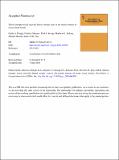Silicon isotopes reveal recycled altered oceanic crust in the mantle sources of ocean island basalts
Abstract
The study of silicon (Si) isotopes in Ocean Island Basalts (OIB) has the potential to discern between different models for the origins of geochemical heterogeneities in the mantle. Relatively large (∼several per mil per atomic mass unit) Si isotope fractionation occurs in low-temperature environments during biochemical and geochemical precipitation of dissolved Si, where the precipitate is preferentially enriched in the lighter isotopes relative to the dissolved Si. In contrast, only a limited range (∼tenths of a per mil) of Si isotope fractionation has been observed from high-temperature igneous processes. Therefore, Si isotopes may be useful as tracers for the presence of crustal material within OIB mantle source regions that experienced relatively low-temperature surface processes in a manner similar to other stable isotope systems, such as oxygen. Characterizing the isotopic composition of the mantle is also of central importance to the use of the Si isotope system as a basis for comparisons with other planetary bodies (e.g., Moon, Mars, asteroids). Here we present the first comprehensive suite of high-precision Si isotope data obtained by MC-ICP-MS for a diverse suite of OIB. Samples originate from ocean islands in the Pacific, Atlantic, and Indian Ocean basins and include representative end-members for the EM-1, EM-2, and HIMU mantle components. On average, δ30Si values for OIB (−0.32 ± 0.09‰, 2 sd) are in general agreement with previous estimates for the δ30Si value of Bulk Silicate Earth (−0.29 ± 0.07‰, 2 sd; Savage et al., 2014). Nonetheless, some small systematic variations are present; specifically, most HIMU-type (Mangaia; Cape Verde; La Palma, Canary Islands) and Iceland OIB are enriched in the lighter isotopes of Si (δ30Si values lower than MORB), consistent with recycled altered oceanic crust and lithospheric mantle in their mantle sources.
Citation
Pringle , E A , Moynier , F , Savage , P S , Jackson , M G , Moreira , M & Day , J M D 2016 , ' Silicon isotopes reveal recycled altered oceanic crust in the mantle sources of ocean island basalts ' , Geochimica et Cosmochimica Acta , vol. 189 , pp. 282-295 . https://doi.org/10.1016/j.gca.2016.06.008
Publication
Geochimica et Cosmochimica Acta
Status
Peer reviewed
ISSN
0016-7037Type
Journal article
Description
EP thanks the Chateaubriand STEM fellowship program for funding. FM thanks the European Research Council under the European Community’s H2020 framework program/ERC grant agreement #637503 (Pristine) and the Agence Nationale de la Recherche for a chaire d’Excellence Sorbonne Paris Cité (IDEX13C445) and for the UnivEarthS Labex program (ANR-10-LABX-0023 and ANR-11-IDEX-0005-02). PS thanks the support of the Marie Curie FP7-IOF fellowship “Isovolc”.Collections
Items in the St Andrews Research Repository are protected by copyright, with all rights reserved, unless otherwise indicated.

